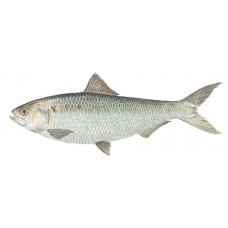Latin name
Alosa sapidissima
Other names
Poor man’s salmon, common shad, Atlantic shad, Connecticut River shad, North River shad, Potomac shad, Susquehanna shad, white shad, Delaware shad, alose; French: alose savoureuse.
Identification
The laterally compressed, rather deep body of the American shad is silvery white, with some amount of green or dark blue along the back, often with a metallic sheen. The coloration darkens slightly when the fish enters fresh water to spawn. Just behind the top of the gill cover is a large black spot, followed by several spots that become smaller and less distinct toward the tail, sometimes there are up to three rows of these dark spots, located one below the other. The American shad has large, easily shed scales, as well as modified scales that form a distinct ridge or cutting edge along the belly. The tail is deeply forked, and the fish's teeth are weak or absent altogether.
Distribution
The endemic range of this species is east of the Appalachian Mountains along the Atlantic coast of North America from the Sand Hill River, Labrador, to the St. John's River, Florida. The American shad was introduced into the Sacramento River in California and is now found along and across the Pacific coast from Bahia de Todos Santos in upper Baja California, Mexico, to Cook Inlet, Alaska.
Habitat
The American shad spend most of their lives in the ocean, ascending into coastal rivers to spawn. They are found in fresh water only during spawning and make extensive and complex migrations throughout their range.
Size
The normal size of an American shad is 2 to 5 pounds. Their maximum size is up to 30 inches. The world record for fishing on all tackle is held by a fish from Massachusetts, weighing 11 pounds, 4 ounces. Although American shad can live up to 13 years, few live to be 7 years old. Females grow faster and are usually the largest.
Life history and Behavior
Most fish first spawn when they weigh 3 to 5 pounds. Males reach sexual maturity at age 3-4, females at age 4-5. Spawning migrations peak when water temperatures reach 50 degrees. These migrations usually occur in April in southern rivers and in July in northern regions. After spawning, the adults try to return to the sea. Many of them die immediately after spawning, while others live long enough to spawn up to seven times.
Food and feeding habits
In the ocean, the American shad feed mainly on plankton. They stop feeding during their spawning migration upstream.
Reproduction
No information
| Classification | |
| Phylum | Chordata |
| Class | Actinopterygii |
| Squad | Clupeiformes |
| Family | Clupeidae |
| Genus | Alosa |
| Species | A. sapidissima |
| Features | |
| Conservation status | Least Concern |
| Habitat | Pelagic |
| Life span, years | No information |
| Maximum body weight, kg | 6 |
| Maximum length, cm | 76 |
| Sailing speed, m/s | No information |
| Threat to people | Edible |
| Way of eating | Planktonophage |


